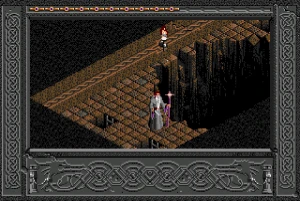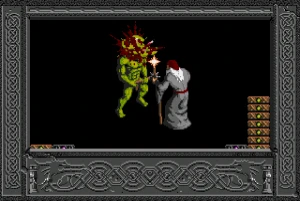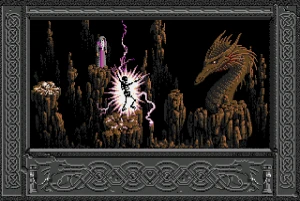Retrogaming Reviews — Latest · Alphabetical · Score · Articles · Site News · Random
Platforms — Arcade · Game Boy · Genesis · NES · PS1 · PSP · Saturn · SNES · TG-16
Sega Genesis / Mega Drive · Action-Adventure · 1991
 Gandalf is in no mood for this shit.
Gandalf is in no mood for this shit.
I Played The Immortal So You Don’t Have To
You’re welcome, by the way.
The Immortal — originally an Amiga game, but later ported to other platforms — is a dungeon-crawling, action-adventure game with some puzzles thrown into the mix. You play the part of an unnamed wizard, delving into the “Labyrinth of Eternity” in search of his long-lost mentor, Mordamir.
The gameplay consists of seven levels[1] of dungeon-crawling, through which you must fight off goblins and other fiendish creatures, avoid dastardly traps, solve cunning puzzles, and generally do your best to just not die horribly. Remember that last part, because it’s going to happen a lot.
The game takes place with a fixed isometric view of the dungeon, where you’ll wander around, interact with the environment, die horribly, solve puzzles, get into fights, and die horribly. The action all takes place within a framed window which, while rather pretty, serves little purpose other than to limit the size of the viewport. There’s also a fairly rudimentary inventory screen, and when you get into combat, there’s a dedicated screen for the combat action — but we’ll get to that later.
Aesthetically, I feel like this game hits the nail right on the head, despite the arbitrarily limited viewport. The theme of The Immortal is very strongly a sort of generic dark-fantasy, and everything about it reinforces this — from the somewhat run-of-the-mill yet decently atmospheric background music, to the dingy and oppressive view of the winding dungeon corridors, to the surprisingly graphic depictions of violence. This is mostly apparent in the combat screen, but even within the dungeon itself, it’s possible — nay, frequent — to be violently devoured by a giant worm or bloodily impaled on a spike trap.
I should note here that despite the limited screen-size, the framerate of the game varies between “okay” and “holy crap why is this so low for no reason”, something I noticed particularly in the waterway section.
 Surprisingly gory for a Genesis game.
Surprisingly gory for a Genesis game.
The Gameplay
As mentioned above, the gameplay consists of exploring the dungeon, navigating traps, and solving puzzles that — while mechanically simple — can be surprisingly tricky. The controls are fine, but can feel a little stiff in parts, while in others — such as when riding on a flying carpet — good luck trying to control that thing and not flying off to Narnia, bouncing off every wall and trap along the way. The flying carpet wasn’t in the original and was added for the console ports — and, frankly, I wish it wasn’t.
Getting into combat with one of the denizens of the deep immediately transitions to a combat screen, and this part is both a strength and weakness of the game. The actual combat system is… it’s bad. Each combatant has a health bar and a fatigue bar, and you’re able to either dodge left or right, or perform one of three attacks (two sideways slashes with your sword, or a stab). Without going into too much detail, suffice to say, basically every single encounter can be won by dodging the enemy’s attacks (which always alternate predictably from one side to the other) until they’re exhausted, then just spamming sideways slashes until they’re dead.
So what makes the combat a strength? Well, its one saving grace is that the death animations are spectacular and surprisingly gory. Heads explode bloodily, bodies are sliced in twain (both horizontally and verticaly), foes are burned to ash or electrocuted to death, decapitated, or even degloved down to their skeletons. It really plays in well with the very dark and grim feel of the game, and it’s surprising to see such graphic violence on a console of this era, outside of the likes of Mortal Kombat.
There isn’t much more to say about the moment-to-moment gameplay — outside of a handful of limited spells, you’re pretty much just puzzle-solving, avoiding traps, and getting into gruesome sword-fights as you descend into the dungeons.
 F
F
The Part Where I Say Unkind Things
Here’s the thing, though: This is a game that’ll appeal to a very specific kind of gamer — the type who has infinite patience, doesn’t mind trial-and-erroring their way through a game, and is fine with replaying the same content over and over. If you like the idea of surviving in a dungeon where all odds are against you, and clawing your way towards victory an inch at a time, then congratulations! Go play The Immortal, you’re in for a great time!
Unfortunately, that kind of gamer is not me.
This is actually not a very long game — if you know what you’re doing, you could probably beat it in an hour and a half. The Immortal pads out its length by being brutally, and very often completely unfairly, difficult. The game’s manual offers a few important hints, but beyond that, it’s very much a case of trying over and over until you figure out the right way to do things, or in some cases, just get lucky enough.[2]
The game intentionally provides a not-insignificant amount of red herrings — many of which can spell your untimely demise — as well as traps or other hazards which are almost impossible to predict without prior knowledge. Several of the puzzles can be absolutely ruined by using an item prematurely or in the wrong way, requiring restarting the level. A couple of parts require almost perfect precision and timing, lest you immediately die and have to try again.
To be fair, you’re given a few lives, where you can resume from the last room you were in, your inventory intact. Run out of lives, however, and you’re back to the start of the level. The game uses a password system to record your progress, but you’re only given a new password once you reach a new level, and some of them can involve a lot of tricky and annoying encounters, pouring extra salt in the wound when you’re sent all the way back to try again from the beginning.
This isn’t so much the “grab a notebook and make lots of notes” kind of puzzle-solving, by the way — it’s more like the “try a dozen times until you figure out how to do it without dying” kind. The puzzles are simple once you’ve figured them out, though some — especially one involving riding on a barrel through a waterway when pursued by a betentacled horror[3] — are just exercises in frustration.[4]
There’s also pretty much no replay value here, aside from speedrunning or just enjoying the aesthetic, as there’s generally only one route through the dungeon with only some very minor variation in a couple of the puzzles. Not that most of us would want to play it again, mind you.
The Verdict

Footnotes
[1] Though, each 'level' can have multiple vertical layers.
[2] I'm looking at you, green slimes.
[3] No, it's not Ultros.
[4] Especially as the framerate in that section goes to absolute shit for no good reason.
Discussion
If your comment doesn't show up right away, don't worry! Sometimes they can be delayed, but it'll appear soon.








